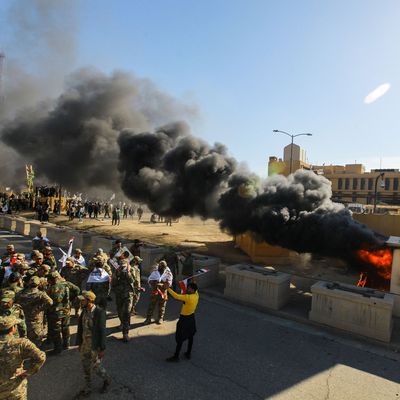
How did we go from President Trump claiming that ISIS was totally defeated, Iran was weakened, and U.S. troops would withdraw from Syria to American diplomats huddled in a Baghdad safe room as U.S. security forces fired tear gas at Iraqi protestors? Three factors led to the attack on the U.S. embassy in Baghdad on Tuesday, and Trump only bears responsibility for two of them. But now he and his administration will have to manage a volatile situation that puts Americans in danger and undercuts his goal of disentangling the U.S. from Middle East conflicts.
The broader context of Tuesday’s attack is that Iraq’s government is weak and disliked by pretty much all wings of a divided Iraqi society. This is not Trump’s doing (though a considerable amount of the blame falls on Washington and the George W. Bush administration for breaking the Iraqi government in 2003 and not doing enough to help Iraqis rebuild). For months, Iraq has been rocked by a tenacious and non-violent youth protest movement that demanded better services and living standards and an end to corruption, while seeking to reach across sectarian and political divides. Iraq’s government has used violence in response, killing hundreds; but the demonstrations have not died down, and other, more violent protests with other ends have sprung up as well.
Trump does bear responsibility for Iraq increasingly becoming the place where U.S.-Iranian tensions play out. One of the reasons given by the Trump administration for breaking off the U.S.-Iran nuclear deal negotiated under President Obama was that it didn’t do enough to restrain Iran’s use of non-government militias it supports to wield influence in Iraq, Syria, and Lebanon. Yet after the Trump administration left the deal and tightened the economic screws on Iran, the country retaliated by becoming more active in Iraq. While Trump spent the last year touting Middle East troop withdrawals, there are still 5,000 American forces in Iraq, plus civilians and contractors. Observers have warned for months that Americans in Iraq are likely targets for Iranian retaliation.
Ironically, civil society protestors seemed to be turning Iraqi society away from Iranian-backed militias and toward the U.S. (meanwhile, Iran’s authoritarian government was busy repressing its own peaceful civic protestors). But then came another mess exacerbated by Trump: his administration’s attempts to deal with the remnants of ISIS and the long conflict in Syria. Despite Trump repeatedly claiming that ISIS was obliterated and U.S. troops were coming home, that hasn’t happened. After Trump ordered U.S. forces to withdraw from the territory they were holding with Kurdish allies earlier this year, those troops were deployed elsewhere along the Iraq-Syria border, or in other parts of the Middle East. The remnants of ISIS have continued their fight, and altogether U.S. troop numbers in the Middle East have risen by about 14,000 since May. It appears that in this confusion, Iranian-backed militias saw an opportunity to increase their influence. In the past two months, there have been 11 rocket attacks on Iraqi bases where U.S. troops were present.
The last such attack took place on Friday at an Iraqi base in Kirkuk; one U.S. contractor was killed and four U.S. troops were wounded. On Sunday, the U.S. responded with attacks on five targets in Iraq and Syria controlled by Kataib Hezbollah, the Iranian back militia group deemed responsible. The U.S. airstrikes killed about two-dozen militia members.
That apparent disproportion was deliberate – the Pentagon’s idea of how to warn off the militias. But the plan backfired. The scale of the attack enraged the Iraqi government and public – which are, 16 years after the U.S. invasion of Iraq, very sensitive about U.S. encroachments on Iraqi sovereignty. Even those parts of Iraqi society that oppose the militias didn’t care for U.S. strikes at such a large scale. When funerals of some of the dead fighters were held in Baghdad Monday, and mourners marched from the gravesites to the U.S. embassy, Iraqi authorities didn’t attempt to stop them. As the fighting escalated, some Iraqi guards helped American security officials protect the diplomats – but there are allegations that others joined in the attacks.
So here is where we are as 2020 dawns: U.S. troops, diplomats, and travelers in the Middle East – but also all over the world – look newly vulnerable. Iraq’s government is weaker, as are the forces for peaceful change inside the country. And who has grown stronger? The very Iranian extremist forces Trump says he wants to undermine. (Also, the Russians who have made themselves friends of Iran … and Syria, and Turkey.)
Even if Trump or the Pentagon truly wanted to stop our “endless wars” in the Middle East by pulling U.S. troops out of the region altogether, it’s now obvious that isn’t going to happen in the next 12 months. On Twitter, Kelly Magsamen, who served in senior national security positions under both presidents Obama and Bush, described what’s needed now: “cool headed leadership and a functioning national security process that effectively develops and evaluates options. We have neither.”
Happy New Year.





























